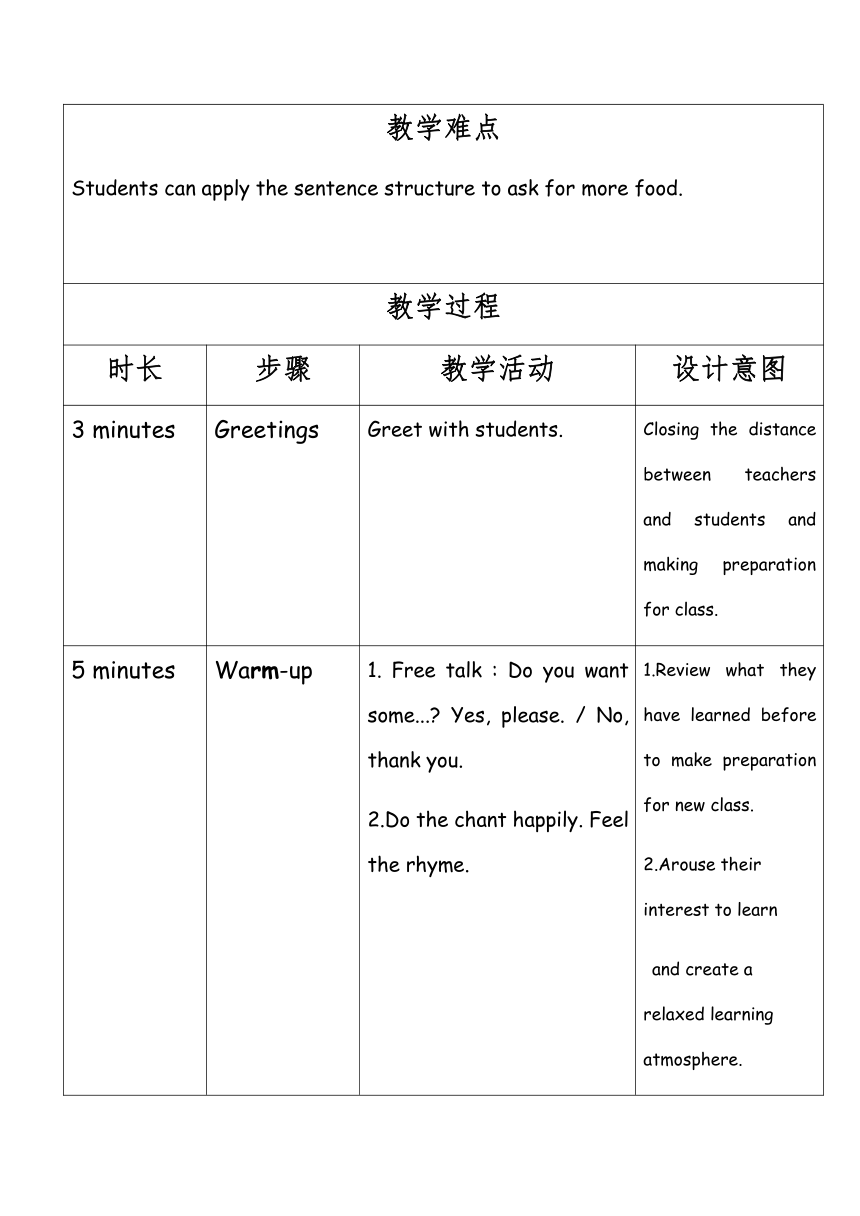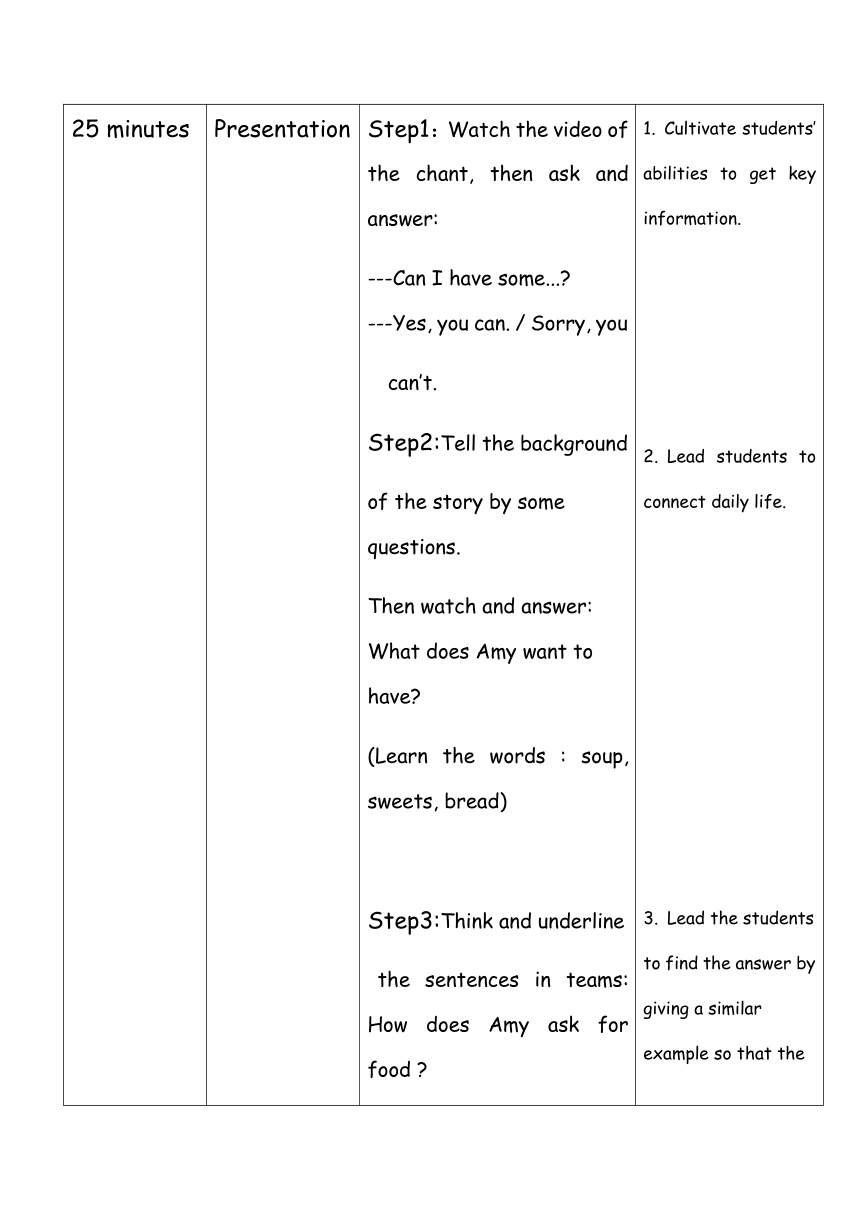Module 6 Unit 1 Can I have some sweets?表格式教案
文档属性
| 名称 | Module 6 Unit 1 Can I have some sweets?表格式教案 |  | |
| 格式 | zip | ||
| 文件大小 | 170.7KB | ||
| 资源类型 | 教案 | ||
| 版本资源 | 外研版(三年级起点) | ||
| 科目 | 英语 | ||
| 更新时间 | 2023-05-04 11:53:57 | ||
图片预览




文档简介
Module 6 Unit 1 Can I have some sweets 教学设计
教学目标 Knowledge Aims: 1.Function:Students are able to ask for food. 2.Grammar:All the students are able to use the sentence structures: I’m hungry. Can I have some... Yes, you can. / Sorry, you can’t. Vocabulary:All the students can understand the words and the phrases: have, hungry, soup, sweets, bread, dark, come here, turn on. All the students are able to use the words and the phrases: have, soup, sweets, bread. Some students are able to use the words and the phrases: come here, can’t see, turn on the light. Ability Aims: Listening:All the students are able to understand the main idea after listening. They are able to understand the sentence structures: I’m hungry. Can I have some... Yes, you can. / Sorry, you can’t. 2.Speaking:All the students are able to speak the sentence structure: I’m hungry. Can I have some... Yes, you can. / Sorry, you can’t. 3.Reading:All the students are able to read the text fluently. 4.Writing:All the students are able to write some sentences to ask for food and answer. Application:All the students are able to use the language they have learned to ask for food and answer. Learning Strategy:Observe some simple English used in life or media. Cultural Consciousness: In learning and daily communication, students can pay more attention to the similarities and differences between Chinese and foreign cultures. Emotional Attitude:Students are willing to use English actively. Tasks: 1. Read in teams and answer questions. 2. Create a new conversation with partners.
教学重点 Students can use the sentence structure to ask for food: I’m hungry. Can I have some... Yes, you can. / Sorry, you can’t.
教学难点 Students can apply the sentence structure to ask for more food.
教学过程
时长 步骤 教学活动 设计意图
3 minutes Greetings Greet with students. Closing the distance between teachers and students and making preparation for class.
5 minutes Warm-up 1. Free talk : Do you want some... Yes, please. / No, thank you. 2.Do the chant happily. Feel the rhyme. 1.Review what they have learned before to make preparation for new class. 2.Arouse their interest to learn and create a relaxed learning atmosphere.
25 minutes Presentation Step1:Watch the video of the chant, then ask and answer: ---Can I have some... ---Yes, you can. / Sorry, you can’t. Step2:Tell the background of the story by some questions. Then watch and answer: What does Amy want to have (Learn the words : soup, sweets, bread) Step3:Think and underline the sentences in teams: How does Amy ask for food Step4:Watch and work in teams and find the answer: Why can’t Amy have some soup, sweets or bread (Learn the word dark and the phrases come here, turn on the light ) Step5: Listen and repeat, then read in teams.(注意模仿语音语调) Step6: Conclude what we have learned. Cultivate students’ abilities to get key information. Lead students to connect daily life. Lead the students to find the answer by giving a similar example so that the students can find the answer efficiently. Learn the sentence structure to ask for food. Cultivate their abilities to work in teams. Cultivate students’ thinking ability and the ability of connecting daily life. 5. Input the original English to insure they can speak rightly and fluently.
6 minutes Production 1.According to the text, make a mind map by themselves. Cultivate students’ thinking ability and the ability of summary.
1 minute Homework 1.Read the text dramatically. 2.Retell the story by your own mind map. You can use your own sentences. Consolidate what they have learned in class. And Train their output ability.
板书设计
教学反思 The teacher leads the students to understand the tasks by giving some examples so that the students can do the tasks effectively. We can see it is so important to give some examples to help the pupils understand the teachers’ tasks and orders from this class. The teacher provides students with some learning methods so that the students can learn how to study in this class. The text is not as difficult as I thought so I needn’t spend so much time on solving the new words. Instead I should spend more time on the production part so that the students could have more time and more chances to express more in English.
教学目标 Knowledge Aims: 1.Function:Students are able to ask for food. 2.Grammar:All the students are able to use the sentence structures: I’m hungry. Can I have some... Yes, you can. / Sorry, you can’t. Vocabulary:All the students can understand the words and the phrases: have, hungry, soup, sweets, bread, dark, come here, turn on. All the students are able to use the words and the phrases: have, soup, sweets, bread. Some students are able to use the words and the phrases: come here, can’t see, turn on the light. Ability Aims: Listening:All the students are able to understand the main idea after listening. They are able to understand the sentence structures: I’m hungry. Can I have some... Yes, you can. / Sorry, you can’t. 2.Speaking:All the students are able to speak the sentence structure: I’m hungry. Can I have some... Yes, you can. / Sorry, you can’t. 3.Reading:All the students are able to read the text fluently. 4.Writing:All the students are able to write some sentences to ask for food and answer. Application:All the students are able to use the language they have learned to ask for food and answer. Learning Strategy:Observe some simple English used in life or media. Cultural Consciousness: In learning and daily communication, students can pay more attention to the similarities and differences between Chinese and foreign cultures. Emotional Attitude:Students are willing to use English actively. Tasks: 1. Read in teams and answer questions. 2. Create a new conversation with partners.
教学重点 Students can use the sentence structure to ask for food: I’m hungry. Can I have some... Yes, you can. / Sorry, you can’t.
教学难点 Students can apply the sentence structure to ask for more food.
教学过程
时长 步骤 教学活动 设计意图
3 minutes Greetings Greet with students. Closing the distance between teachers and students and making preparation for class.
5 minutes Warm-up 1. Free talk : Do you want some... Yes, please. / No, thank you. 2.Do the chant happily. Feel the rhyme. 1.Review what they have learned before to make preparation for new class. 2.Arouse their interest to learn and create a relaxed learning atmosphere.
25 minutes Presentation Step1:Watch the video of the chant, then ask and answer: ---Can I have some... ---Yes, you can. / Sorry, you can’t. Step2:Tell the background of the story by some questions. Then watch and answer: What does Amy want to have (Learn the words : soup, sweets, bread) Step3:Think and underline the sentences in teams: How does Amy ask for food Step4:Watch and work in teams and find the answer: Why can’t Amy have some soup, sweets or bread (Learn the word dark and the phrases come here, turn on the light ) Step5: Listen and repeat, then read in teams.(注意模仿语音语调) Step6: Conclude what we have learned. Cultivate students’ abilities to get key information. Lead students to connect daily life. Lead the students to find the answer by giving a similar example so that the students can find the answer efficiently. Learn the sentence structure to ask for food. Cultivate their abilities to work in teams. Cultivate students’ thinking ability and the ability of connecting daily life. 5. Input the original English to insure they can speak rightly and fluently.
6 minutes Production 1.According to the text, make a mind map by themselves. Cultivate students’ thinking ability and the ability of summary.
1 minute Homework 1.Read the text dramatically. 2.Retell the story by your own mind map. You can use your own sentences. Consolidate what they have learned in class. And Train their output ability.
板书设计
教学反思 The teacher leads the students to understand the tasks by giving some examples so that the students can do the tasks effectively. We can see it is so important to give some examples to help the pupils understand the teachers’ tasks and orders from this class. The teacher provides students with some learning methods so that the students can learn how to study in this class. The text is not as difficult as I thought so I needn’t spend so much time on solving the new words. Instead I should spend more time on the production part so that the students could have more time and more chances to express more in English.
同课章节目录
- Module 1
- Unit 1 Go straight on.
- Unit 2 It's at the station.
- Module 2
- Unit 1 She's reading a book.
- Unit 2 What are you doing?
- Module 3
- Unit 1 What are they doing?
- Unit 2 What's the elephant doing?
- Module 4
- Unit 1 Do you want some rice?
- Unit 2 How much is it?
- Module 5
- Unit 1 Can you ran fast?
- Unit 2 Can Sam play football?
- Module 6
- Unit 1 Can I have some sweets?
- Unit 2 Happy Halloween!
- Module 7
- Unit 1 There is a horse in this photo.
- Unit 2 There are twelve boys on the bike.
- Module 8
- Unit 1 We're going to visit Hainan.
- Unit 2 Sam is going to ride horse.
- Module 9
- Unit 1 Are you going to run on Sports Day?
- Unit 2 I'm going to do the high jump.
- Module 10
- Unit 1 We have a big family dinner.
- Unit 2 Merry Christmas!
- Review Module
- Unit 1
- Unit 2
